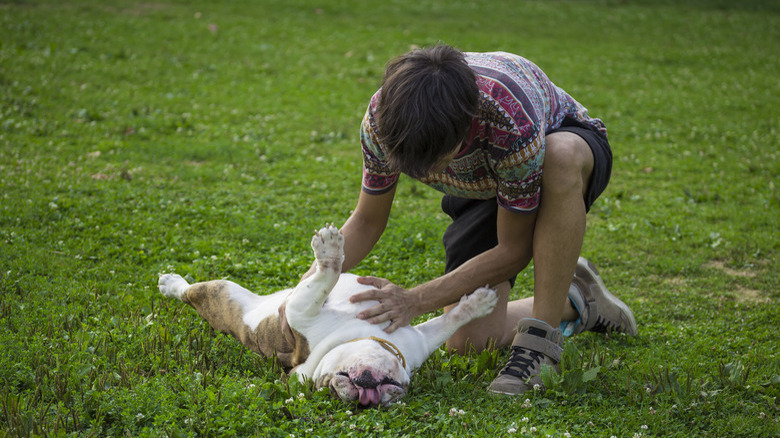Diseases Of The Scrotum In Dogs
A dog's nether region is usually not the first place people look when he's not feeling well, but it's as integral a part of his furry body as any other. Even if your male dog has been neutered, it pays to pay attention to changes in his genital area.
We can't count on our best friend to speak up when he's hurting down there. It's up to us to notice a problem. If you brush your dog, make checking his genitals part of your routine as you groom his rear end and back legs. A belly rub session is also a good time to take a look. Check for scrapes, cuts, scratches, redness, and swelling. Notice if he's licking himself a lot. If he has genital pain, he may even refuse to walk or eat. If you notice any of this, see if he's running a fever.
The only sure way to know if your dog has a fever is to take his temperature rectally. A dog's normal temperature ranges from 99.5 to 102.5 degrees Fahrenheit. A temperature of 104.5 and above warrants a trip to the vet as soon as possible. If you're uncomfortable taking your dog's temperature, look for signs that he may be running a fever, such as a hot and dry nose, very warm ears, shivering, lethargy, and not eating.
Male dog parts and problems
The scrotum is the pouch of skin that contains the testes, a male dog's two reproductive glands. The skin of the scrotum is thin, hairless, and devoid of fat. It helps to regulate the temperature of the testes by carrying them away from your dog's tummy, where the temperature is several degrees higher. The scrotum can also contract when it's cold in order to keep your dog's testicles close and warm.
Scrotal skin can become irritated or injured just like any other skin on your dog's body. Mild inflammation, rashes, and minor cuts or scrapes on the scrotum can be treated the same as you would if they were anywhere else. Soothing aloe vera, antibiotic ointment, or a product containing hypochlorous acid like Vetericyn can be used. However, if your dog's scrotum looks unusually swollen or discolored or if he appears to be in pain and/or is running a fever, it's time to get him to the vet.
Swollen and shrunken dog testicles
If your dog is not neutered, a swollen scrotum can indicate that his testes are inflamed. Suddenly inflamed testes are most often caused by direct trauma, but infections and viruses like distemper can also be the cause.
In a neutered dog, a swollen scrotum is also usually the result of trauma, but if you've recently had him neutered, know that it's not uncommon for the scrotum to swell after neuter surgery. The swelling can look like he has enormous testicles. You may wonder if the vet actually did the surgery properly, but don't worry.
When your male dog is neutered, the vet makes a small incision in the scrotum and removes each testicle. Post-op swelling is a collection of fluid and clotting and is a normal response to the surgery. It starts to subside in a few days. The scrotum should look normal again in seven to 10 days. If it doesn't, have your vet take a look. Over time, an empty scrotum will shrink in size, and the skin will become wrinkled. This too is normal.
Inflamed dog testicles
Most dogs' scrotums are greyish in color regardless of the skin color on the rest of their bodies. Some are darker, even black. You might see pink spots on the scrotum, especially in a young dog. Minus any other symptoms, these colors and minor color changes are no cause for alarm. However, there is one exception—red is not OK.
If your dog's balls are red, this can mean he has an infection. Do not try to treat an infection yourself. Get him to a vet. In addition to the probability of infection, a red scrotum can also be caused by an inflammation of the bladder, a scrotal hernia, or testicular torsion.
Testicular torsion happens when one or both testes in an unneutered male dog twist. It can block blood flow and is very painful. Testicular torsion warrants an emergency trip to your vet or nearest pet emergency clinic.
Always check with your veterinarian before changing your pet's diet, medication, or physical activity routines. This information is not a substitute for a vet's opinion.
